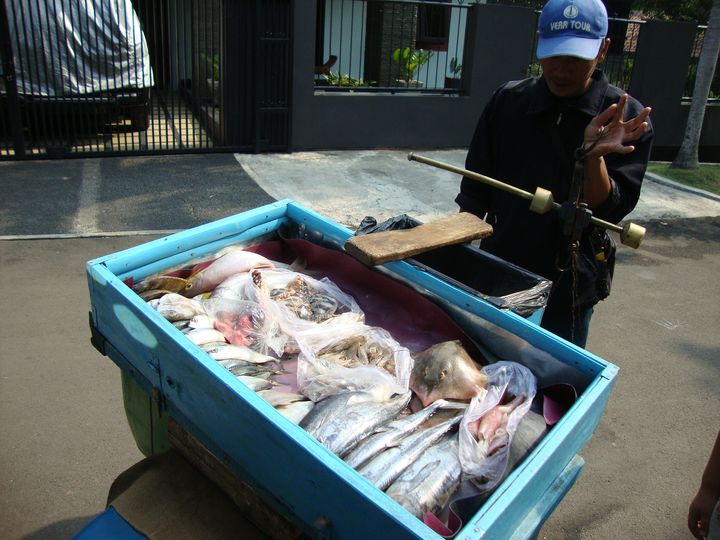Is the practice of “buy today eat today” one of the solutions to preventing food waste?

Growing up in Bogor, West Java, Indonesia. I would wake up in the morning to a familiar holler from the front of my house “Yur! Yur! Sayur Neng!!” ( Veg, Veg, Vegetables Miss). My mother would then go out to greet the Tukang Sayur (Mobile vegetable vendor) around 6:30am. This is how the conversation would often sound like:
Vendor: What are you planning to cook today?
Mother: Hmm I’m thinking spinach soup. Do you have anything good?
Vendor: This is really fresh, it’s 5000 Rupiah for this bunch;
Mother: Ok, I’ll just get two. How about this corn, is it sweet?
Vendor: Yes, how about you pair it with this tempeh. It’s a good combination
Mother: Nah, I had tempeh yesterday. I’ll just grab a small bag of the potatoes. I’m going to make perkedel kentang (potato croquets). Can you bring me a nice cut of beef tomorrow, all cleaned and cut? I want to make semur (beef stew).
Vendor: Sure. See you tomorrow!

This interaction is probably alien to most supermarket shoppers in the West. The back and forth banter and the fact that the vendors make suggestions on menus and what’s fresh and in season is a common part of daily food provisioning practice in Indonesia. But how are mobile vegetable vendors connected to food waste?
Buy today eat today
Currently, there is a marked distinction in how the issues of food waste are framed, namely that consumer food waste is largely a problem in developed countries while food loss is generally the problem in developing countries. In a study it was argued that one of the reasons for a lack of consumer food waste studies in developing countries is the predominance of a “buy today eat today practice.” The question that I ask in my study is “what are the types of food infrastructures that can support and promote a “buy today eat today” practice?”
So what is a “Buy Today Eat Today Practice”? In essence it is a practice of only buying what you need for the day and consuming it all in one day. In contrast, the general (“modern”) shopping practice in North America, entails stocking up groceries once or twice a week. The buy today eat today practice also leads to less storage of food in the refrigerators. As we know from various studies and campaigns to reduce food waste, food storage due to weekly groceries “stocking up” is often an issue. Households often forget foods at the back of the fridge or leave the lettuce to wilt in the crisper.
While many researchers investigate consumer behaviour and infrastructures to manage food waste (in the form of composting bins), there is a lack of study on food provisioning infrastructures that can support consumers in preventing and reducing household food waste.This is where a comparison of shopping practices at different is particularly important.
The terminology used in Indonesia for “shopping when you are hungry” is called “Lapar Mata” (literally “Hungry Eyes” or Shopping with your eyes). This is premised on the idea that without sticking to a list, consumers are often tempted to buy more than what they need. Consumers are tempted by an endless array of food as well as deals such as the ubiquitous “buy one get one free” offers. While policies have recognized the role of supermarkets in food waste prevention and reduction, there are a limited number of food infrastructure options in the West. In Indonesia, and many other developing countries, small-scale vendors like Udin prevent the type of shopping of the Lapar Mata category. In fact, it is common for households to tailor their menu for the day depending on the seasonal products that the vendors will bring.
The role played by small to medium-scale food vendors in preventing overconsumption is important. Firstly, the variety of goods that can be carried by these vendors in their wooden cart or motorcycles are limited. This labour intensive job requires a large labour pool to cover entire swaths of neighbourhoods and increases job opportunities. In addition, because the vendors come everyday with new foods, there is no need to stock up on fresh produce. The mobile vegetable vendors also purchase their foods from the traditional wetmarket, which is generally local and seasonal. Therefore, not only do these small-scale infrastructures help households prevent food waste, it also supports a more localized short distance food economy. In general, shopping from vegetable vendors also leads to eating more fresh and whole foods rather than processed foods. Unlike supermarkets, lack of refrigeration and a small cart/motorcycle means that vendors do not themselves stock lots of food, and they also do not sell processed foods with the exception of tofu and tempeh (although occasionally meatballs and sausages).
However, Indonesia’s tukang sayur may soon be wiped out with the growing numbers of multinational supermarkets and the development of large elite enclave. As one Tukang Sayur told me in an interview with regards to price wars:
“If we are talking about comparing my net income before and now, we’re talking about a huge difference. Since Giant* [*a multinational hypermarket chain] arrived, my net income now is much smaller compared to the past. It’s because of the price difference; the prices at Giant and the prices at the wetmarket are different. I need to make some profit to feed my family…”
Increasingly, these vendors are also barred from elite housing complexes as the housing enclaves are usually located near major hypermarkets and the vendors are seen as a “nuisance” and competition. As an urban planner focusing on the issue of household food waste, it is my goal to raise awareness of planners’ role in developing policies that will ensure the long term support for these necessary small-scale food infrastructures.
